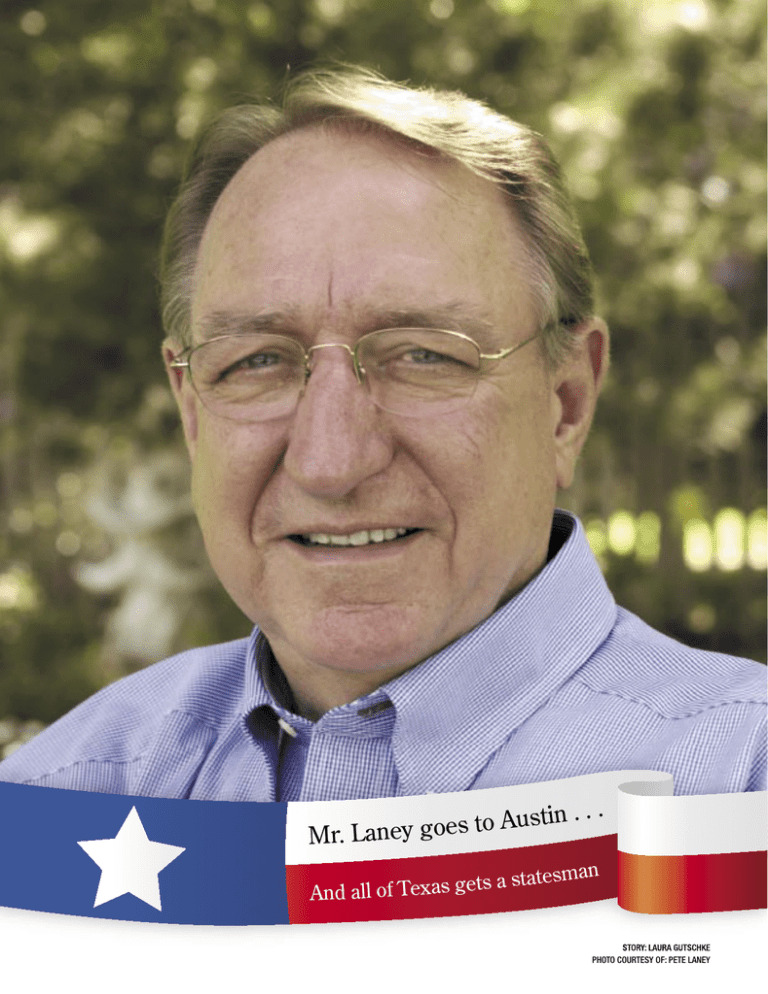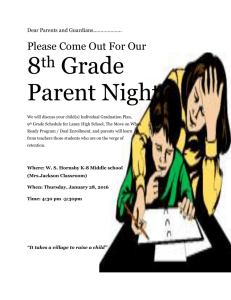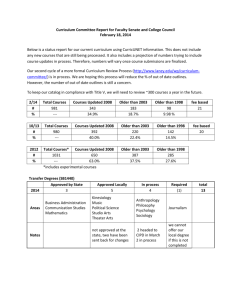������������� ������������������ � ������������
advertisement

������ � � � � � � � � � � ��������������� ������ � � � � � � � � � � � � � ��������������� Page 2 | Landmarks 2007 STORY: LAURA GUTSCHKE PHOTO COURTESY OF: PETE LANEY H E’S WORKED WITH some of the icons of Texas politics, sat with titans of business and addressed a national television audience to introduce the 43rd President Of The United States. But, when James E. “Pete” Laney (‘65, B.S. in agricultural economics) reflects upon the benchmarks of his 34 years as a state representative, including a record-tying five terms as speaker of the House of Representatives, the group he refers to the most is the constituents. When constituents contacted his office in the district or at the Texas Capitol with issues ranging from problems with retirement benefits to input on pending legislation, Laney had one mandate: take care of them. When the Legislature was in session and 16-hour workdays were the norm, he still made time to meet with individuals who came by his office, especially those with disabilities or other physical hardships. After fellow representatives elected him speaker in 1993, Laney enacted new rules on how legislation is processed to increase public access to the proceedings. “I wanted to let the public have input in the process, and to make sure members of the House had an opportunity of having their legislation heard. Every member of the House has a constituency, and that constituency needs to be represented in the legislative process,” said Laney. And by constituency, he means all the people in Texas, regardless of voting record or party affiliation. Staying in touch with the people of his district became a greater challenge over the last three decades because of Texas’ population growth and county shifts with each of the last three redistricting measures. When he first took office on Jan. 1, 1973, Laney’s district consisted of about 75,000 people in Hale and Swisher counties and part of Lubbock County. In his last term, Laney represented the recently redrawn House District 85, which stretches across 16 counties and includes about 150,000 people. WHY POLITICS Laney was born in 1943 and grew up on a family farm seven miles northwest of Hale Center that was also one and a half miles from where his great-grandfather, originally started farming in 1905. In high school, Laney participated in many extracurricular activities and at Texas Tech University was active in student government and Phi Delta Theta fraternity. Despite serving on the Student Senate at the university, he had no political aspirations after graduation. He worked on the farm and, after earning his pilot’s license in the early 1960s, flew for a charter service. (He later owned an aerial spraying service.) He decided to run for the House of Representatives in 1972 after four-term veteran Ralph Wayne chose not to run again. Redistricting caused Laney to face off against a four-term fellow Democrat Delwin Jones. “I had listened to people complain about problems with the government, but they did not want to do anything about it—some of them didn’t even vote,” said Laney. THE GROUP HE REFERS TO THE MOST IS THE CONSTITUENTS Grass roots, down home and cordial might best describe Laney’s first race. Friends managed his campaign, wrote news releases and helped him design campaign brochures, all without pay. Laney and primary opponent Jones occasionally traveled together to public forums. Laney went on to win the primary and the seat, taking office in 1973. Jones and Laney have remained friends throughout the years, and Jones returned to the House of Representatives in 1989 after switching to the Republican Party. After becoming speaker in 1993, Laney appointed him to important committees, including chair of the House Redistricting Committee. MAKING A MARK IN AUSTIN In his first term in the 63rd Legislature, Laney and about half of the representatives were freshmen because of the Sharpstown Stock-Fraud Scandal that resulted in the departure of several incumbent politicians. In addition, newcomers filled the three most powerful Texas government positions: Gov. Dolph Briscoe, Lt. Gov. William P. “Bill” Hobby and House Speaker Price Daniel, Jr. “The institutional memory was not there, so there was a big learning curve for us. But, it was also an advantage to us new ones because there Page 3 was a more level playing field,” said Laney, who was appointed to the Agriculture, Environmental Affairs and Transportation committees. The learning curve was further facilitated in 1974 when members of the House and Senate came together for a constitutional convention to attempt to re-write the Texas Constitution. Although members failed by three votes to have a final document presented to voters, Laney said a silver lining of the seven-month event was that many working relationships were forged between members of both houses. When he returned to Austin in 1975, for his second term, new House Speaker Bill Clayton appointed him chairman of the Committee on Administration, a position he retained for eight years. In effect, the post made Laney, Clayton’s right-hand man in running the House of Representatives. He next served as chairman of the Committee on State Affairs for 10 years under House Speaker Gib Lewis. During his first 20 years of public service in Austin, Laney provided leadership on economic development, health care and public education issues that especially benefited rural and smaller cities. Laney garnered statewide praise in 1991 for authoring an ethics reform bill, which is still in effect today, that required greater public accountability of legislators. LEADER OF THE HOUSE In 1993, Laney was elected unanimously as Speaker of the House. His first major order of business was changing House Rules governing the legislative process. The Calendar Committee, which votes on which bills move to the House for consideration by all, was required to meet publicly. In addition, a series of deadlines was implemented for proposed bills to make their way through to the House body, eliminating the lastminute flurry of activity that often saw legislators considering hundreds of bills in the last few days of the session. Perennial watchers of Texas politics describe Laney’s five terms as speaker as an era of bipartisanship. “My committee chairmen were both Democrat and Republican. I appointed them because of their abilities, not their party affiliation,” said Laney. He also encouraged members to vote what was best for their constituents and did not punish members if they voted their district over their party. “You’re elected to the House by your district constituency and you’re elected Speaker of the House by the other 149 house members so, as speaker, you serve two constituencies,” Laney said. “I worked hard for the people in my district, but I also worked hard for my fellow legislators Page 4 | Landmarks 2007 and helped them with their legislative programs. I may not have been enamored with a legislator’s bill, but if it was important to him and his constituents, then we had a process available for them to sell their program. Only if the program adversely affected my district did I interject myself into the process,” said Laney. One of Laney’s close friends was fellow Democrat Bob Bullock, who had served as a representative, secretary of state, comptroller and lieutenant governor. Bullock, who died in 1999, I WORKED HARD FOR THE PEOPLE IN MY DISTRICT was outspoken—completely opposite of Laney’s soft-spoken, congenial disposition. But, the two shared a mutual friendship and a love for Texas. “Bob and I wanted to do what was best for Texas, and when that’s your main objective, then it’s easy to get along, and things go better in the legislative process,” said Laney. To that end, Democrats Laney and Bullock met for breakfast once a week with Repub– lican Governor George Bush when the three served together. When Governor Bush was declared President of the United States in mid-December 2000, he asked his friend Laney to introduce him to the worldwide audience. From the podium of the House of Representatives, Laney introduced the new president and spoke of how Bush worked with members of both parties to take care of the people’s business in Texas. POLITICAL CHANGES Starting in the1990s, Republicans progressively made more gains in the House, Senate and statewide offices. In 2003, Republicans controlled the House of Representatives for the first time in more than 120 years, and Republican Tom Craddick from Midland was chosen as speaker. Laney continued to work as diligently as usual in the House, even though his committee assignments were less prestigious than in years past. ‘PETE’ LANEY’S OBSERVATIONS ON POLITICS, FARMING AND MORE “When Bush was elected president, we didn’t export Texas politics to Washington as we had hoped. We imported Washington politics to Texas.” “Production agriculture is the only business in the world where the producer goes to market and says,” ‘What will you give me for this product?’ It’s one of the few industries that does not pass its expenses on.” “There are people you meet in life whom you admire and from whom you can learn, and you want to take advantage of what they know. I definitely did that. It started in my family with my grandfather and I continue to learn from others today.” “I’m thankful to my supporters for placing their trust in me for so long. I’m thankful for the opportunity to represent the values and ideas of this area—hard work, fairness, integrity and bipartisanship. I’ve always said it’s amazing what you can accomplish when you don’t care who gets the credit—and, together we have accomplished a lot.” - From news release announcing Laney would not seek re-election As part of statewide redistricting, Laney’s dis- FACT FILE trict was redrawn in 2003 heavily favoring Re- Family: Married the former Nelda McQuien (B.S. ’65) in 1963. All three of their children and their spouses are graduates of Texas Tech. KaLyn Laney oversees the Governmental Relations Department for the State Bar of Texas; Jamey Phillips, an attorney, lives in Lubbock is married to attorney Ronald Phillips and they have four sons; and J. Pete, an attorney, lives in Austin is married to Melonie and they have one son. Public Service: The list of committees, boards and commissions who have benefited from Laney’s presence is extensive. In addition, he was elected president of the National Speakers Conference, chairman of the Southern Legislative Conference and to the executive committee of the National Conference of Sate Legislatures. He currently serves as Chairman of the National Advisory Board of the Ranching Heritage Association and is a member of the board of trustees for the Texas Scottish Rite Hospital. Awards: Some of the awards include Outstanding Texas Leader of the Year by the John Ben Shepperd Public Leadership Institute; Texan of the Year by the Texas Legislative Conference; Advocacy Award for Public Officials by the Child Welfare League of America; Friend of Education Award by the Texas Classroom Teachers Association; Distinguished Alumnus Award in 1988 and Outstanding Agriculturist in Public Service Awards in 1993, both from the College of Agricultural Sciences and Natural Resources; Distinguished Alumnus Award in 1991 by Texas Tech Alumni Association; and an honorary doctorate from Wayland Baptist University. publicans. The 16-county district is now shaped like a small “t”—stretching as far north as Hale County with the city of Plainview to 200 miles south to Reagan and Irion counties. It extends from Terry County and the city of Brownfield in the west to Jones County in the east—just above the city of Abilene. Despite the district being about 62 percent Republican, Laney won re-election in November 2004 with almost 59 percent of the vote. After more than three decades of public service, Laney announced his retirement from the House in December 2005, and his term expired on Jan. 9, 2007. The list of awards from many diverse groups that represented teachers, police officers, firefighters, universities, children, health care pro- viders, agriculture and business on the local, state and national level over the years are a testament to the value of Laney’s public service. Laney credits his success also to his wife, Nelda, whom he met while they attended Texas Tech University. Each legislative session, until their children reached high school age, Nelda, KaLyn, Jamey and J Pete, moved to Austin, giving him a stable, calming home life that kept him centered amid the flurry of Capitol activity. Laney returned home each week to stay in touch with his district. Nelda taught school in Hale Center after graduation and later established a reputation for herself as a selfless, dynamic volunteer in Austin and West Texas circles. She was co-chair of the Capitol Fund Drive, which solicited private funding for the restoration of the State Capitol and was vice-chair of the Texas Capitol Restoration Celebration. Nelda created a series of collectible Capitol ornaments and raised millions for preservation of the Capitol. To date, she has now designed 24 ornaments for various organizations, including Keep Texas Beautiful. LANEY CREDITS HIS SUCCESS ALSO TO HIS WIFE, NELDA Laney continues to farm cotton in Hale County, and he works his public schedule around spending time with his children and five grandsons. Laney also serves on the executive committee of the Southern Legislative Conference, which fosters intergovernmental cooperation between the 16 states in the South, and on the executive committee of the National Speakers Conference, which is composed of current and former speakers of state legislatures. And, despite the latest flavor of rancor in Austin politics, Laney still believes in the importance of public service. To that end, he’s working with college-aged students to encourage them to become involved in the political process. “Because I’m not running for re-election, people think I’m not busy, but I am,” said Laney. Page 5





